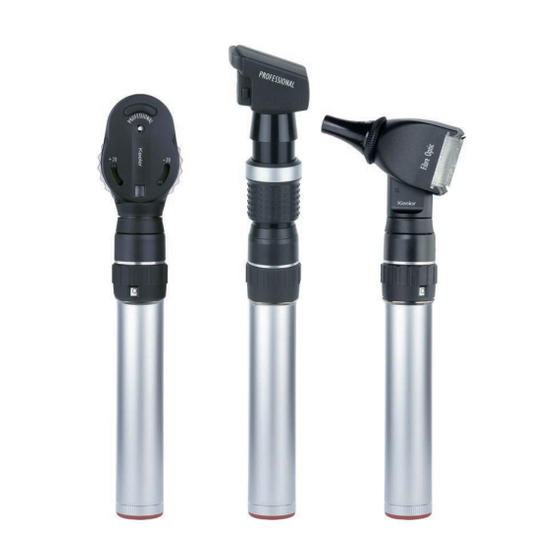
Summarization of Contents
General Safety Information
Device Classification Details
Classifies ophthalmoscopes, retinoscopes, and otoscopes according to medical device directives.
General Warnings and Cautions
Provides general warnings and cautions for safe operation and handling of the diagnostic instruments.
Continued Safety Precautions
Additional General Safety Warnings
Continues general safety advice on temperature, children, condensation, indoor use, and maintenance.
Charger Safety Guidelines
Provides safety advice for using chargers, including mains adapter sockets and power cords.
Instrument-Specific Safety
Diagnostic Instrument Safety Precautions
Details safety precautions for connecting heads, controls, magnets, ambient temperatures, and speculae.
Battery and Bulb Safety
Covers safety guidelines for handling batteries, ensuring correct orientation, and avoiding mixing battery types.
Further Battery and Bulb Safety
Battery and Bulb Safety (Continued)
Continues safety advice on handling batteries, short circuits, disposal, and bulb/LED temperature.
Ophthalmoscope Controls and Features
Lens Wheel Operation
Explains how the lens wheel is rotated to select lenses and displays power values.
Auxiliary Lens Wheel Function
Details the function and adjustment of the auxiliary lens wheel for dioptre steps.
Ophthalmoscope Lens Ranges
Lists the dioptre ranges available for Specialist, Professional, Practitioner, Standard, and Pocket models.
Graticule Control and Types
Explains the graticule control and the function of different graticules (Wide Angle, Intermediate, Macular, Slit).
Ophthalmoscope Graticule and Filter Details
Graticule Control Details
Further describes graticule functions like Glaucoma and Fixation Cross aids.
Filter Control and Applications
Explains the filter control and details filter applications like Red Free and Cobalt Blue for specific uses.
Pupillometer Usage
Explains how to use the pupillometer to estimate pupil size and its measurement range.
Retinoscope Instrument Heads
Brow Rest for Spectacle Wearers
Explains the purpose of brow rests for spectacle wearers and how to interchange them.
Aperture Control Function
Details the two positions of the aperture control for changing aperture size.
Retinoscope Focussing and Axis Control
Explains vergence adjustment for spot and streak retinoscopes and its effects.
Otoscope Features and Usage
Otoscope Speculae and Pneumatic Testing
Explains fitting disposable speculae and performing pneumatic testing with an insufflation tube.
Otoscope Magnifier Adjustments for Surgery
Details magnifier adjustments on various Otoscope models for minor surgical procedures.
Instrument Head Maintenance
Bulb Replacement Procedure
Provides step-by-step instructions for safely replacing bulbs or LEDs in instrument heads.
Instrument Handle Operation and Compatibility
Connecting Instrument Heads to Handles
Explains the screw thread connection method for attaching instrument heads to handles.
Handle and Head Compatibility
Details compatibility between ophthalmoscopes, retinoscopes, and LED modules with Keeler handles.
Instrument On/Off and Brightness Adjustment
Explains how to switch instruments on/off and adjust brightness using the control.
Instrument Handle Identification and Upgrades
Handle and Battery Identification
Describes colour coding for identifying handles and matching battery voltages.
Recommended Dry Cell Batteries
Lists the recommended dry cell batteries for Keeler Pocket and C size handles.
Upgrading to Rechargeable Handles
Guides users on upgrading C-size handles from dry cell to rechargeable, including bulb voltage changes.
Instrument Handle Battery Charging
Battery Charging Guidelines
Warns against charging non-rechargeable batteries.
Rechargeable Battery Conditioning Process
Provides a step-by-step conditioning process for Keeler rechargeable batteries to maximize life.
Charger Compatibility Information
Lists Keeler chargers compatible with Keeler rechargeable handles.
GenMed Wall Unit Power Supply Assembly
Set Plug Installation
Instructs on replacing the blanking plate with appropriate mains plug adaptors or using a specific connector.
GenMed Wall Unit Operation and Interference
Connecting Heads to Wall Unit Handles
Details how to screw instrument heads onto the wall unit handles securely.
Electromagnetic Interference Warning
Warns about potential electromagnetic interference affecting or being affected by the equipment.
GenMed Wall Unit Instrument Use and Specula Dispensing
Using Instruments from Wall Unit
Explains how to remove and return handles to cradles, and the function of the cradle LED.
Dispos-A-Spec Speculum Dispenser
Explains how to dispense and refill specula from the Dispos-A-Spec unit.
Chargers and Charging Procedures
Charger Power Supply Setup
Instructs on assembling the power supply and connecting it to the charger.
Battery Charging Status Indicators
Explains the LED indicators for battery charging status (fully charged, top up, charging).
Charger and Battery Usage
Details charging times, battery life, and the prohibition of use during charging.
Cleaning and Sterilization Methods
Instrument Cleaning Procedures
Outlines manual non-immersion cleaning steps for the instrument using specific solutions.
Reusable Specula Sterilization
Details manual cleaning and validated steam sterilization procedures for reusable speculae.
Specifications and Electrical Ratings
Transport, Storage, and Operating Conditions
Provides environmental conditions for transport, storage, and operation of the equipment.
Power Supply Input Data
Specifies mains input voltage, frequency, rating, and operational duty cycle.
Equipment Classification
Indicates equipment classification and shock protection type.
Handle and Head Voltage Requirements
Lists input voltage requirements for instrument heads and handles based on battery type.
Contact and Disposal Information
Disposal of Electrical and Electronic Equipment
Provides information on the disposal of electrical and electronic equipment according to WEEE guidelines.

















Need help?
Do you have a question about the Otoscope and is the answer not in the manual?
Questions and answers